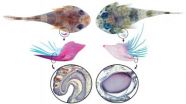(Press-News.org) As news reports of lithium-ion battery (LIB) fires in Boeing Dreamliner planes and Tesla electric cars remind us, these batteries — which are in everyday portable devices, like tablets and smartphones — have their downsides. Now, scientists have designed a safer kind of lithium battery component that is far less likely to catch fire and still promises effective performance. They report their approach in the Journal of the American Chemical Society.
Lynden Archer, Geoffrey Coates and colleagues at Cornell University explain that the danger of LIBs originates with their electrolytes, the substance that allows ions to flow between the electrodes of the battery. The electrolyte usually contains a flammable liquid. To minimize this fire hazard, some researchers are developing more stable, solid electrolytes. But although solid electrolytes are less likely to fuel a fire, their ability to transport ions has fallen short, especially at room temperature. Coates's team set out to tackle both issues and come up with a safer, high-performance battery component, while Archer's team studied the electrochemical characteristics of the materials.
The team's efforts have led to a new family of solid polymer electrolytes that is both good at conducting lithium ions at room temperature and minimizing the risk of fire. Not only are these materials safer than their liquid counterparts in LIBs, but they could also be used in high-energy lithium-metal batteries, such as promising lithium-sulfur and lithium-air batteries.
INFORMATION:
The authors acknowledge funding from the Energy Materials Center at Cornell, which receives support from the U.S. Department of Energy.
The American Chemical Society is a nonprofit organization chartered by the U.S. Congress. With more than 161,000 members, ACS is the world's largest scientific society and a global leader in providing access to chemistry-related research through its multiple databases, peer-reviewed journals and scientific conferences. Its main offices are in Washington, D.C., and Columbus, Ohio.
To automatically receive news releases from the American Chemical Society, contact newsroom@acs.org.
Follow us: Twitter Facebook
In the wake of high-profile battery fires, a safer approach emerges
2014-05-14
ELSE PRESS RELEASES FROM THIS DATE:
Relationship satisfaction linked with changing use of contraception
2014-05-14
Women's sexual satisfaction in long-term heterosexual relationships may be influenced by changes in hormonal contraceptive use, research from the University of Stirling shows.
The study, published in Psychological Science, a journal of the Association for Psychological Science, was carried out by researchers from the universities of Stirling, Glasgow, Newcastle, Northumbria and Charles University in Prague.
The team looked at a sample of 365 couples, and investigated how satisfaction levels – in both sexual and non-sexual aspects of long-term relationships – were influenced ...
A new approach to treating peanut and other food allergies
2014-05-14
These days, more and more people seem to have food allergies, which can sometimes have life-threatening consequences. In ACS' Journal of Agricultural and Food Chemistry, scientists report the development of a new type of flour that someday could be used in food-based therapies to help people better tolerate their allergy triggers, including peanuts.
Mary Ann Lila and colleagues note that of the 170 foods that cause allergic reactions, peanuts can be the most dangerous. These reactions can range from mild itching and hives to life-threatening anaphylactic shock, in which ...
Extinct relative helps to reclassify the world's remaining 2 species of monk seal
2014-05-14
The recently extinct Caribbean monk seal (Monachus tropicalis) was one of three species of monk seal in the world. Its relationship to the Mediterranean and Hawaiian monk seals, both living but endangered, has never been fully understood. Through DNA analysis and skull comparisons, however, Smithsonian scientists and colleagues have now clarified the Caribbean species' place on the seal family tree and created a completely new genus. The team's findings are published in the scientific journal ZooKeys.
First reported by Columbus in 1494, the Caribbean monk seal ranged ...
Research reveals New Zealand sea lion is a relative newcomer
2014-05-14
The modern New Zealand sea lion is a relative newcomer to our mainland, replacing a now-extinct, unique prehistoric New Zealand sea-lion that once lived here, according to a new study.
A team of biologists from New Zealand's University of Otago estimates that this prehistoric mainland sea-lion population became extinct as recently as 600 years ago, and was then replaced by a lineage previously limited to the waters of the cold subantarctic.
The Marsden-funded study, carried out by Otago Zoology PhD student Catherine Collins, and led by Professor Jon Waters, set out ...
New technology simplifies production of biotech medicines
2014-05-14
The final step in the production of a biotech medicine is finishing with the correct sugar structure. This step is essential for the efficacy of the medicine, but it also makes the production process very complex and expensive. Leander Meuris, Francis Santens and Nico Callewaert (VIB/UGent) have developed a technology that shortens the sugar structures whilst retaining the therapeutic efficiency. This technology has the potential to make the production of biotech medicines significantly simpler and cheaper.
Sugar structures are essential for the mechanism of biotech ...
@millennials wary of @twitter, #MSU study finds
2014-05-14
EAST LANSING, Mich. --- A new study indicates young adults have a healthy mistrust of the information they read on Twitter.
Nearly anyone can start a Twitter account and post 140 characters of information at a time, bogus or not, a fact the study's participants seemed to grasp, said Kimberly Fenn, assistant professor of psychology at Michigan State University.
"Our findings suggest young people are somewhat wary of information that comes from Twitter," said Fenn, lead investigator on the study. "It's a good sign."
The study, funded by the National Science Foundation, ...
Prevent premature deaths from heart failure, urges the Heart Failure Association
2014-05-14
Athens, 14 May 2014. The Heart Failure Association (HFA) of the European Society of Cardiology (ESC) is calling for global policy change relating to heart failure. An international white paper, Heart failure: preventing disease and death worldwide, will be presented at an endorsement event on 16 May 2014 in Athens, Greece, immediately before the Heart Failure 2014 Congress.
Approximately 15 million people are living with heart failure in Europe,1 and 26 million worldwide.2 The outlook is poor: survival rates are worse than those for bowel, breast or prostate cancer, and ...
Understanding the 1918 flu pandemic can aid in better infectious disease response
2014-05-14
COLUMBIA, Mo. – The 1918 Flu Pandemic infected over 500 million people, killing at least 50 million. Now, a researcher at the University of Missouri has analyzed the pandemic in two remote regions of North America, finding that despite their geographical divide, both regions had environmental, nutritional and economic factors that influenced morbidity during the pandemic. Findings from the research could help improve current health policies.
"Epidemics such as the Black Death in the 14th century, cholera in the 19th century and malaria have been documented and recorded ...
Tiny, tenacious and tentatively toxic
2014-05-14
COLLEGE STATION – Sometimes we think we know everything about something only to find out we really don't, said a Texas A&M University scientist.
Dr. Kevin Conway, assistant professor and curator of fishes with Texas A&M's department of wildlife and fisheries sciences at College Station, has published a paper documenting a new species of clingfish and a startling new discovery in a second well-documented clingfish.
Smithsonian Institution
The paper, entitled "Cryptic Diversity and Venom Glands in Western Atlantic Clingfishes of the Genus Acyrtus (Teleostei: Gobiesocidae)," ...
Chapman University affiliated physicist publishes on the Aharonov-Bohm effect in Nature
2014-05-14
ORANGE, Calif. – Chapman University affiliated quantum physicist Yutaka Shikano, Ph.D., has published a milestone paper in the prestigious journal Nature Communications. The title of the article is "Aharonov-Bohm effect with quantum tunneling in linear Paul trap." The Aharonov-Bohm (AB) effect was proposed by Yakir Aharonov, who is the co-director of the Institute for Quantum Studies at Chapman University, and David J. Bohm in 1959.
The AB effect showed for the first time that a magnetic field inside a confined region can have a measureable impact on a charged particle ...



